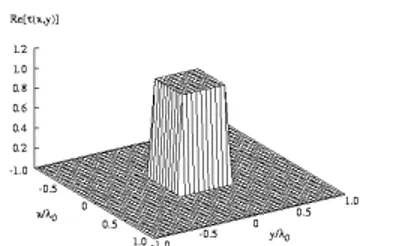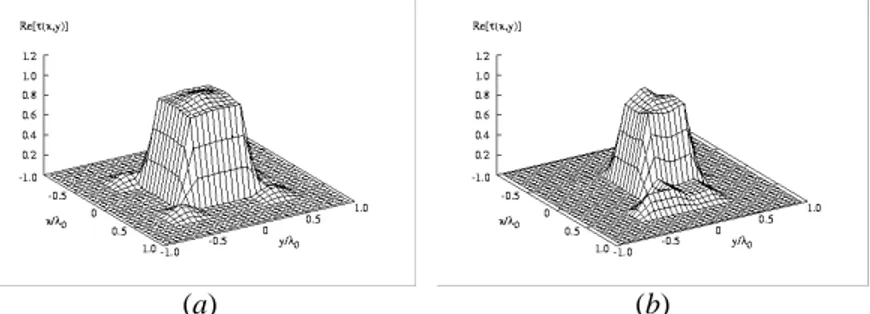UNIVERSITY
OF TRENTO
DIPARTIMENTO DI INGEGNERIA E SCIENZA DELL’INFORMAZIONE
38123 Povo – Trento (Italy), Via Sommarive 14
http://www.disi.unitn.it
A TWO-STEP STRATEGY FOR A MULTI-SCALING INVERSION
OF PHASELESS MEASUREMENTS OF THE TOTAL FIELD
R. Azaro, D. Franceschini, G. Franceschini, L. Manica, and A. Massa
January 2011
A Two-Step Strategy for a Multi-Scaling Inversion of Phaseless
Measurements of the Total Field
Renzo Azaro, Davide Franceschini*, Gabriele Franceschini, Luca Manica, and Andrea Massa
Department of Information and Communication Technologies, University of Trento, Via Sommarive 14, I-38050 Trento, Italy.
E-mail: [email protected], Web-page: http://www.eledia.ing.unitn.it
This work presents an innovative two-step methodology for the electromagnetic imaging from amplitude-only measurements of the total field. At the first stage, an inverse source algorithm is used to estimate the distribution of the incident field inside the investigation area. Successively, the unknown profile is directly retrieved from phaseless data by means of an iterative multiresolution procedure integrated with a particle swarm optimizer.
Introduction
The non-invasive reconstruction of unknown objects by means of microwave imaging techniques is receiving a growing interest in several applications [1]-[2]. It is well known [3] that the main drawbacks are due to the ill-posedness and the non-linear nature of the arising inverse scattering problem that is generally solved in a non-linear fashion defining a regularized solution. Obviously, in order to reconstruct the object profile, a non-negligible amount of information has to be acquired by multi-view/illumination and/or multi-frequency systems and, nevertheless, an upper bound for the collectable information remains [4]. Consequently, the space of the unknowns has to be reduced by considering a-priori information and/or constraints on the scenario under test, or by employing multiresolution strategies (e.g., [5]-[6]).
In addition to the intrinsic drawbacks of an inverse problem, there are others practical issues concerned with the realization of measurement setups, which turn out to be considerably simplified, and consequently less expensive, when designed for the acquisition of amplitude-only data.
For this reason, several effective strategies have been developed in order to directly process phaseless data (Single-Step Strategies, [7]-[8]). Alternatives approaches consist in splitting the phaseless-data reconstruction into a two-step process (Two-Step Strategy) where the original problem is recast to a complete data reconstruction through a phase-retrieval algorithm for completing the amplitude-only data [9].
As a matter of fact, a different and, to the best of author’s knowledge, innovative two-step procedure is presented in this paper. The first stage determines the input data for the state equation for phaseless inputs without attempting to complete the amplitude-only scattering data, while the second stage deals with a phaseless-data reconstruction through a suitable multi-scaling algorithm in order to fully exploit the limited amount of collectable information. Moreover, the local minima problem is dealt with by considering a suitable hill-climbing optimizer called PSO [10].
In the framework of amplitude-only methods, the proposed two-step approach requires the measurement of the scattering data in a limited number of locations in the observation domain, so that the data collection is considerably simplified both in terms of measurement setup and acquisition time.
Mathematical Formulation
Let us consider a classical tomographic microwave imaging problem where the acquisition system is supposed to collect only the amplitude of the total field,
) ( ,.., 1 , ) , ( m m v v tot x y m M
E = , in the observation domain . Moreover, let us assume available the knowledge of the amplitude of the incident field in subdomains of the area under investigation,
obs D N ) , ( n n v inc x y
E n=1,...,N . Under these hypotheses, the arising scattering phenomena can be described through the following system of nonlinear integral equations [3]
{
}
{
}
(2) ) 1 ( , ) , ( ), , ( ) , ( ) , ( , ) , ( ), , ( ) , ( int n n n n I v tot n n n n v tot n n v inc obs m m n n v tot n n ext m m v tot D y x y x E y x y x E y x E D y x y x E y x y x E ∈ Ω − = ∈ Ω = τ τwhere Ωext and Ωint are the external and internal scattering operators, respectively. Stating from such set of equations, the unknown distribution of the object function
) , (xn yn
τ has to be reconstructed in the region . Certainly, the use of phaseless data (PD) turns out in a further reduction of the collectable information on the scenario under test with respect to that already limited of the full data (FD) situation. In order to effectively exploit such a limited amount of information and to achieve a suitable resolution accuracy, a customized procedure based on the adaptive multi-scaling approach (IMSA)
I
D
[6] could be of great advantage. It requires the iterative minimization (s=1,...,S ) of the following cost function
{
}
{
}
∑∑∑
∑∑∑
∑ ∑
∑ ∑
= = = = = = = = = = Ω − − + Ω − = Φ V v s r N n r n r n v inc V v s r N n r n r n s v tot r n r n s r r n r n s v tot r n r n v inc V v M m m m v tot V v M m r n r n s v tot r n r n s r ext m m v tot s y x E y x E y x y x E y x E y x E y x E y x y x E v v 1 1 1 2 ) ( ) ( 2 1 1 1 ) ( ) ( ) ( ) ( ) ( ) ( ) ( int ) ( ) ( ) ( ) ( ) ( 1 1 2 2 1 1 ) ( ) ( ) ( ) ( ) ( ) ( ) ( ) ( ) , ( ) , ( ), , ( ) , ( ) , ( ) , ( ) , ( ), , ( ) , ( ) ( ) ( τ τ (3)In practical experiment, the measurement of Eincv (xn,yn) in a dense grid of is not often feasible, so that we assume the knowledge of the incident field (both in amplitude and phase) in the measurement points of . Thus, since Eq. (3) requires the knowledge of the radiated field in the whole , a complete modeling of the e. m. source is necessary. Such a step can be performed off-line before the acquisition of the scattering measures. Therefore, the retrieval process is split in two different stages:
I D obs D I D
1. Source Synthesis
. The actual source is modeled by means of a linear array of
W equally-spaced line-sources calibrated starting from the measurement of
) ,
(xm ym , ( )
,..,
1 M v
,
in order to synthetically simulate the values ofv inc E m= ) , ( n n v inc x y E in a whatever position of DI.
2. Reconstruction of the scenario. The amplitude only-data are inverted through the procedure detailed in [6] for minimizing the cost function (3) by means of a Particle
Numerical Results
For a preliminary assessment of the two-step strategy, let us consider a centered square scatterer (
2
λ
=
ref
L
sided
) with homogeneous dielectric characteristics (τref =1.0). Such cylinder (Fig. 1) is located in a square investigation domain of side Lref =2λ illuminated by plane waves impinging from V =32 equally-spaced directions.Figure 1. Centered square dielectric cylinder. Reference distribution of the object function.
The data are collected on a circular observation domain (Robs =5λ in radius) in , , equally-distributed measurement points.
32
) (v =
M v=1,...,V
As far as the PSO-based method for the minimization process is concerned, the configuration of its parameters has been adopted according to the guidelines in the related literature (see [10] and the reference therein). The constant inertial weight has been chosen equal to w=0.4, the swarm dimension I U
100 5
= (U being the number of problem unknowns) and the acceleration coefficients have been set toC1= C2 =2.0
.
Moreover, the IMSA has been used with the parameters setting defined in [6].After the definition of the line-source array model (Source Synthesis), the reconstruction procedure based on a “bare” (that is non-multiresolution) PSO based algorithm has provided the results illustrated in Fig. 2. The profiles retrieved with the FD approach [Fig. 2(a)] (shown for comparisons purposes) and with the PD approach [Fig. 2(b)] do not exhibit significant differences and the reconstruction errors are of about
for both
the simulations.
% 5
On the contrary, the accuracy of the reconstruction improves when combining the optimization technique with the IMSA procedure.
(a) (b)
Figure 2. Centered square dielectric cylinder. Reconstructed profile by means of the PSO FD
Fig. 3 displays the final reconstructions obtained at the convergence step (
)
when processing full data [Fig. 3(a)] or amplitude-only data [Fig. 3(b)]. Both of them turn out to be quite close to the actual one. The only difference can be noticed observing that the PD inversion slightly shifts the center of the object with respect to its reference position. The localization errors (i.e. the distance2 =
S
γ of the estimated centre from the actual one) confirm such an indication, being γPD =2.80λ while γFD =0.02λ
.
(a) (b)
Figure 3. Centered square dielectric cylinder. Reconstructed profile by means of the IMSA-PSO
FD Approach (a) and the IMSA-PSO PD Approach (b).
References:
[1] J. Ch. Bolomey, "Microwave imaging techniques for NDT and NDE," Proc. Training
Workshop on Advanced Microwave NDT/NDE Techniques, Supelec/CNRS, Paris,
Sep. 7-9, 1999.
[2] Q. Fang, P. M. Meaney, and K. D. Paulsen, "Microwave imaging reconstruction of tissue property dispersion characteristics utilizing multiple-frequency information,"
IEEE Trans. Microwave Theory Tech., vol. 52, pp. 1866-1875, Aug. 2004.
[3] M. Bertero and P. Boccacci, Introduction to Inverse Problems in Imaging. IOP Publishing Ltd, Bristol, 1998.
[4] O. M. Bucci and T. Isernia, "Electromagnetic inverse scattering: Retrievable information and measurement strategies," Radio Sci., vol. 32, pp. 2123-2138, Nov.-Dec. 1997.
[5] E. L. Miller and A. Willsky, "A multiscale, statistically based inversion scheme for linearized inverse scattering problems," IEEE Trans. Geosci. Remote Sensing, vol. 34, pp. 346-357, Mar. 1996.
[6] S. Caorsi, M. Donelli, D. Franceschini, and A. Massa, "A new methodology based on an iterative multiscaling for microwave imaging," IEEE Trans. Microwave Theory
Tech., vol. 51, app. 1162-1173, Apr. 2003.
[7] M. Lambert and D. Lesselier, "Binary-constrained inversion of a buried cylindrical obstacle from complete and phaseless magnetic fields," Inverse Problems, vol. 16, pp. 563-576, 2000.
[8] S. Caorsi, A. Massa, M. Pastorino, and A. Randazzo, "Electromagnetic detection of dielectric scatterers using phaseless synthetic and real data and the memetic algorithm," IEEE Trans. Geosci. Remote Sensing, vol. 41, pp. 2745-2753, Dec. 2003. [9] L. Crocco, M. D'Urso, and T. Isernia, "Inverse scattering from phaseless
measurements of the total field on a closed curve," J. Opt. Soc. Am. A, vol. 21, Apr. 2004.
[10] M. Donelli and A. Massa, "Computational approach based on a particle swarm optimizer for microwave imaging of two-dimensional dielectric scatterers," IEEE

